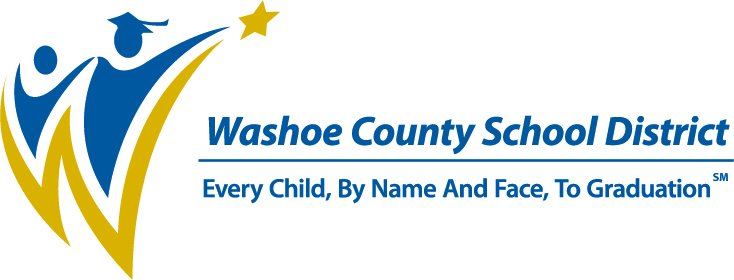
Washoe County School District creates “Equity Guidebook”
Incidents
The Washoe County School District has an “Equity Guidebook” to help “continually build district-wide capacity around Equity, Diversity, Inclusion, and Social Justice.” The guidebook describes the idea of “colorblindness” as “racial erasure” and argues that a focus in classrooms should be on race. The guidebook promotes implementing “culturally responsive practices.” The term “culturally responsive” is often used to describe a method of teaching that includes the race and ethnicity of students as part of the lessons taught in classrooms. The district’s guidebook lists “barriers to cultural proficiency” in schools that include the following:
- Systems of Oppression: That racism, sexism, heterosexism, ableism, and classism exist is without refute, historically and currently. Data re on the side of documenting and describing the ill effects of such systems. Being able to understand oppression as a systemic issue apart from personal behavior is important.
- A Sense of Privilege and Entitlement: Systems of oppression have two effects – on those who are harmed and on those who benefit. Those harmed from systemic oppression respond from an emotional connection, as well as from being well informed of practices that impact them negatively. On the other hand, many of those who benefit from historical and current practices are oblivious to the negative effects of systemic oppression, because they can choose not to see.
- Unawareness of the Need to Adapt: Many educators and schools often struggle with change that involves issues of culture. For those who are resistant, change often is experienced as an outside force that judges current practices as deficit or defective. Whether accurate or not, an adversarial relationship exists between those forcing the change and other members of the school community.
The guidebook promotes numerous equity resources for educators that include videos titled “BuzzFeedVideo: Students Learn A Powerful Lesson about Privilege,” “Chescaleigh: 5 Tips for Being an Ally,” and “Clint Smith: The Danger of Silence.” Books listed as resources include A Culturally Proficient Response to LGBT Communities: A Guide for Educators, A Culturally Proficient Society Begins in School: Leadership for Equity, and Culturally Proficient Collaboration: Use and Misuse of School Counselors. Several organizations are also listed as resources, including Learning for Justice and Teaching for Change.
Learning for Justice is an organization known for pushing its “Social Justice Standards” to be adopted in schools throughout the country. The document for these standards includes goals to achieve for students. One goal is that “students will develop language and historical and cultural knowledge that affirm and accurately describe their membership in multiple identity groups.” Another goal appears to outright state that the purpose of the “Social Justice Standards” is to turn students into political activists: “Students will make principled decisions about when and how to take a stand against bias and injustice in their everyday lives and will do so despite negative peer or group pressure.”
Teaching for Change is an organization that promotes implementing blatantly left-wing politics into the curricula of schools. The organization promotes the Zinn Education Project, Black Lives Matter at School, and a list of books that include LGBTQ and transgender topics for children. Teaching for Change claims to encourage “teachers and students to question and re-think the world inside and outside their classrooms; build a more equitable, multicultural society; and become active global citizens.”
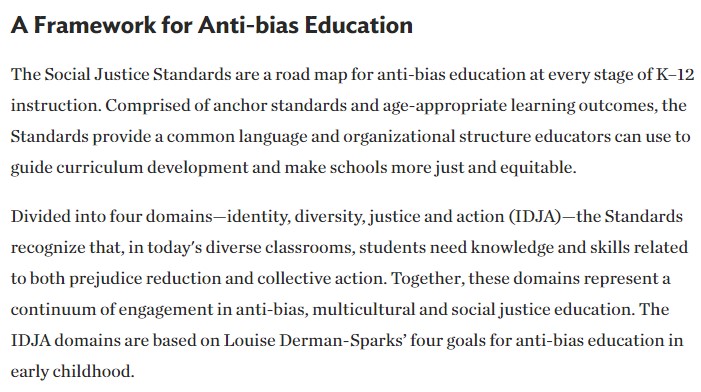
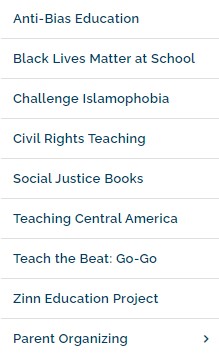
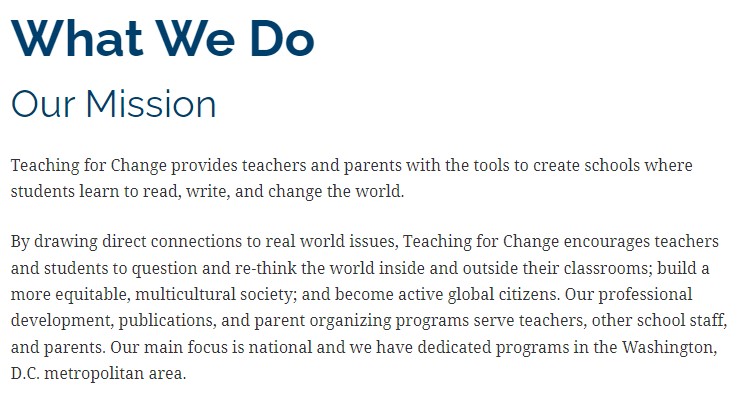
The school district has a document showing how ESSER funds are being used. Part of the ESSER funding will be used for providing teachers with “equity and diversity training.” The document explains the purpose of spending ESSER funds on equity:
Specialists also work on incorporating multicultural and equity education proficiency and awareness into the curriculum, supporting, and coordinating special programs, and using data to identify disparities in achievement and access to opportunities. These funds will expand the number and consistency of Specialists by adding one additional Equity and Diversity Specialist to focus on curriculum and professional learning. The primary work of the Equity and Diversity Specialists is to build capacity among site-based personnel to carry out equitable and culturally responsive practices.
The school district has part of its website dedicated to “Equity and Diversity.” The district explains that a goal is to focus on the “social identity” of students in its push for equity: “Families are encouraged to help their child understand who they represent in society in terms of age, sex, gender, race, nationality, socio-economic status, linguistic ability, religion, sexual orientation, disability, and other social membership.” The district then pushes for families to participate in political activism to “reform biased curriculum standards and instructional practices.” The district explains:
Families are encouraged to participate in district, regional, state, and national efforts to reform biased curriculum standards and instructional practices. This can be achieved through small and large efforts. Small efforts include families’ support of their child’s school through occasional or ongoing volunteer efforts, as well as contacting their local government. Large efforts include families’ ongoing support of organizations that support reform, or by becoming a volunteer for Washoe County School District.
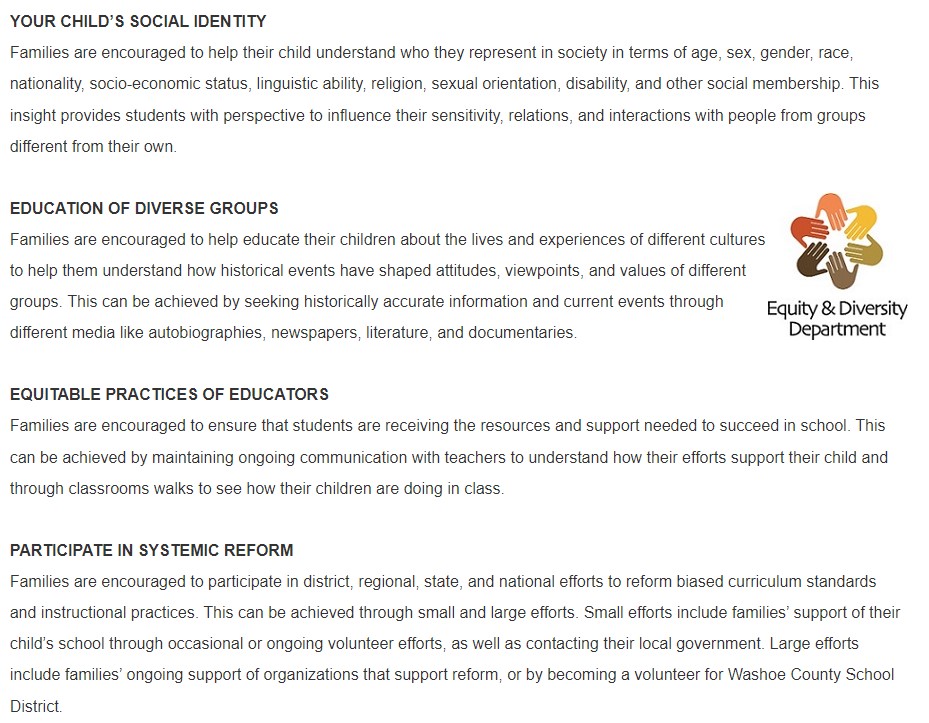
The district additionally has several lists of equity resources for teachers and families. One list is labeled as “Social Justice.” This list guides teachers to several of the district’s resources to promote equity and social justice. The district explains in the list that teachers participate in “Equity 101 Trainings” that involve discussions of “privilege and entitlement.”
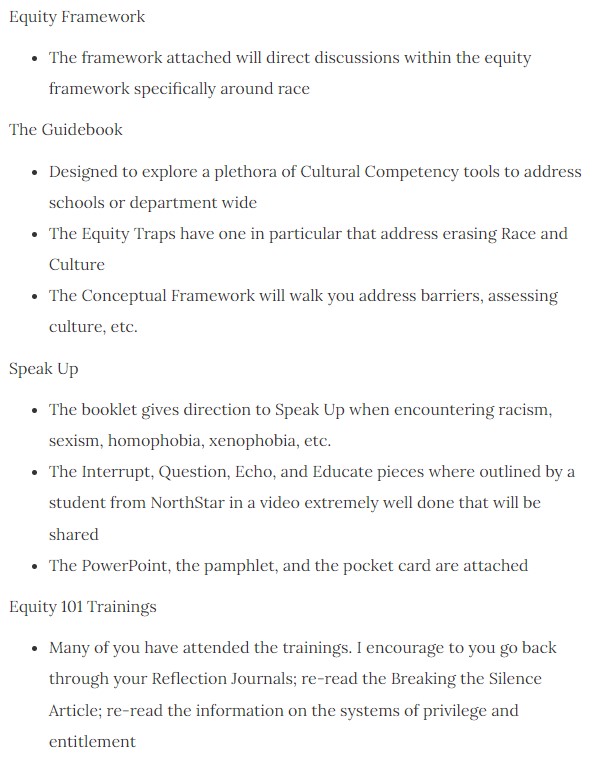
Stay Informed

